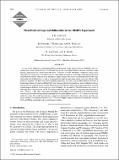Float-Derived Isopycnal Diffusivities in the DIMES Experiment
Author(s)
Balwada, D.; Speer, K.; Ferrari, Raffaele; Tulloch, Ross; LaCasce, Joseph H., 1964-; Marshall, John C; ... Show more Show less
DownloadLaCasce-2014-Float-Derived Isopyc.pdf (2.461Mb)
PUBLISHER_POLICY
Publisher Policy
Article is made available in accordance with the publisher's policy and may be subject to US copyright law. Please refer to the publisher's site for terms of use.
Terms of use
Metadata
Show full item recordAbstract
As part of the Diapycnal and Isopycnal Mixing Experiment in the Southern Ocean (DIMES), 210 subsurface floats were deployed west of the Drake Passage on two targeted density surfaces. Absolute (single particle) diffusivities are calculated for the floats. The focus is on the meridional component, which is less affected by the mean shear. The diffusivities are estimated in several ways, including a novel method based on the probability density function of the meridional displacements. This allows the determination of the range of possible lateral diffusivities, as well as the period over which the spreading can be said to be diffusive. The method is applied to the float data and to synthetic trajectories generated with the Massachusetts Institute of Technology General Circulation Model (MITgcm). Because of ballasting problems, many of the floats did not remain on their targeted density surface. However, the float temperature records suggest that most occupied a small range of densities, so the floats were grouped together for the analysis. The latter focuses on a subset of 109 of the floats, launched near 105°W. The different methods yield a consistent estimate for the diffusivity of 800 ± 200 m[superscript 2] s[superscript −1]. The same calculations were made with model particles deployed on 20 different density surfaces and the result for the particles deployed on the neutral density surface γ = 27.7 surface was the same within the errors. The model was then used to map the variation of the diffusivity in the vertical, near the core of the Antarctic Circumpolar Current (ACC). The results suggest mixing is intensified at middepths, between 1500 and 2000 m, consistent with several previous studies.
Date issued
2014-02Department
Massachusetts Institute of Technology. Department of Earth, Atmospheric, and Planetary SciencesJournal
Journal of Physical Oceanography
Publisher
American Meteorological Society
Citation
LaCasce, J. H., R. Ferrari, J. Marshall, R. Tulloch, D. Balwada, and K. Speer. “Float-Derived Isopycnal Diffusivities in the DIMES Experiment.” J. Phys. Oceanogr. 44, no. 2 (February 2014): 764–780. © 2014 American Meteorological Society
Version: Final published version
ISSN
0022-3670
1520-0485